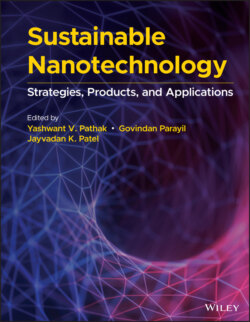Читать книгу Sustainable Nanotechnology - Группа авторов - Страница 84
3.7.2 Environmental Related Risks
ОглавлениеThe unused nanoparticles or waste nanomaterials during synthesis may agglomerate into larger particles or longer chains with modified physical and chemical properties, which may expose to the environment and may enter the human body and spread toxicity. Unused silver nanoparticles if mishandled may contaminate sewage sludge and affect the microorganisms of soil of agricultural fields. The silver nanoparticles show a toxic effect on fishes and other marine animals in the ocean. Silver nanoparticles at high concentrations may be toxic at high concentrations. Thus, it is assumed that nanotechnological products, processes, solutions, and different applications may affect significantly to the environment and climate. Thus, nanoparticles are likely to be more toxic due to their particle size, surface charge, and characteristics compared to bulk materials and hence may pose a risk to the environment.
